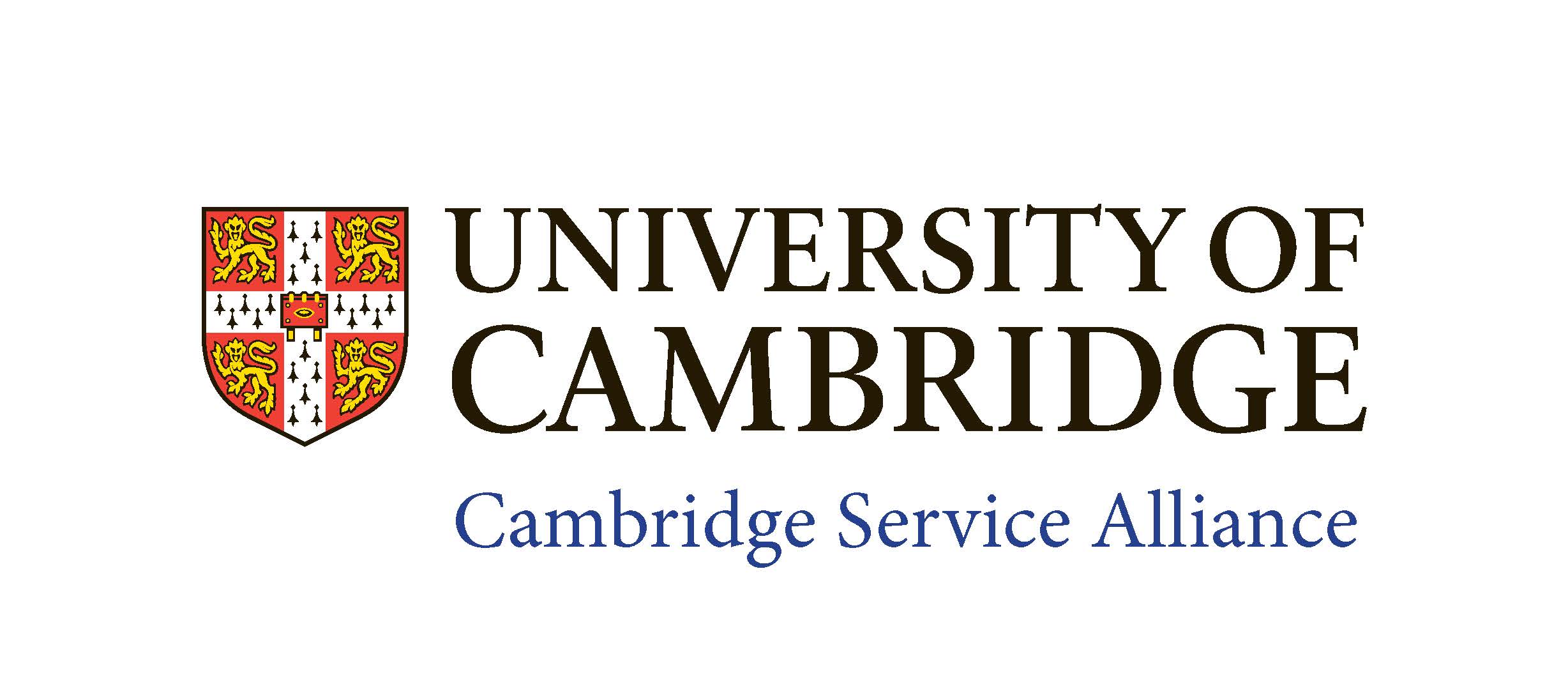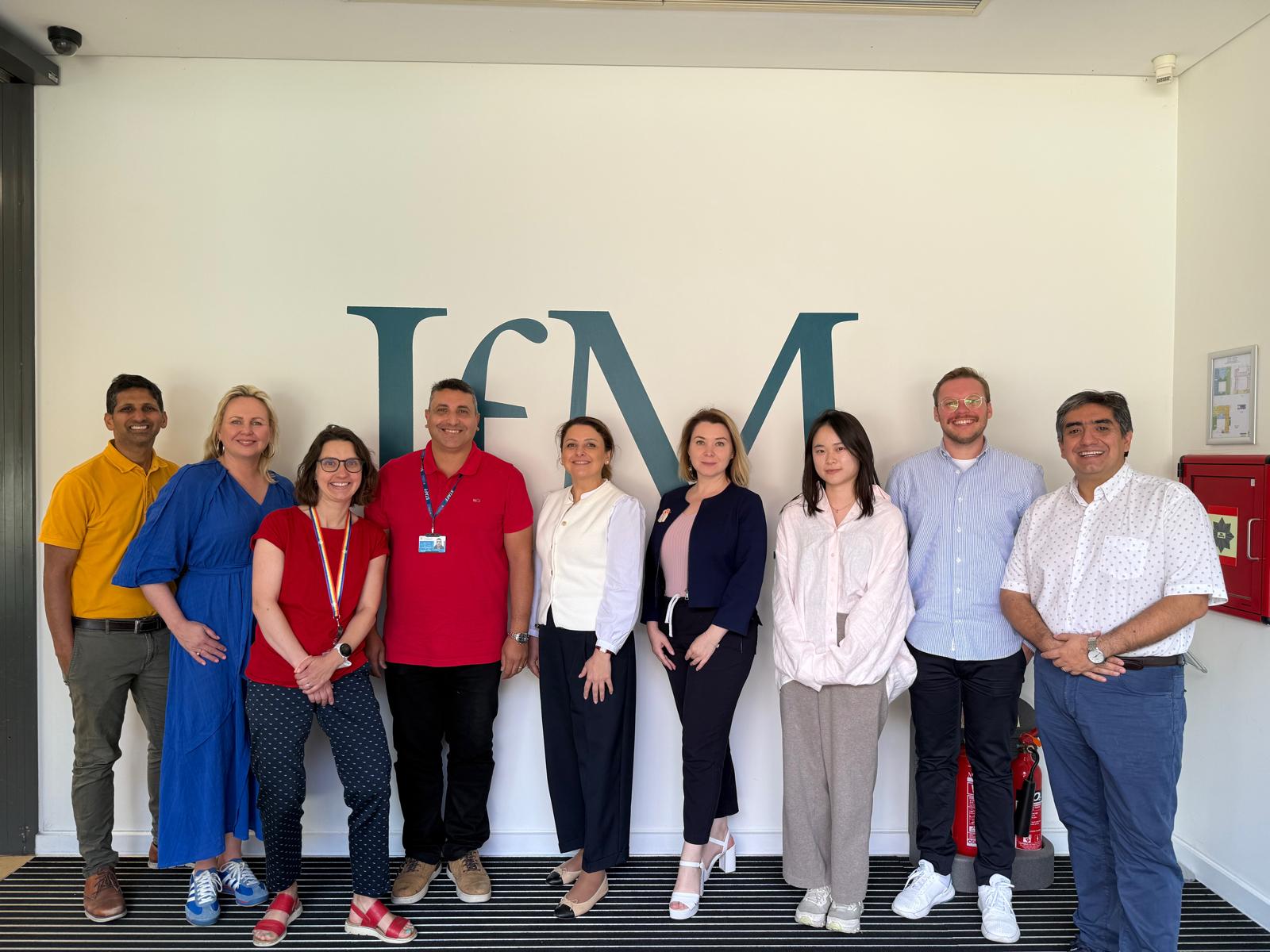Brian Holliday,
Managing Director, Siemens Digital Factory, Siemens plc
Design, Make and Service in a Digital World – A Siemens Perspective on Industry 4.0
Brian Holliday is Managing Director for Siemens Digital Factory which serves the manufacturing and infrastructure sectors in the UK, Ireland and Nigeria. He is a member of the Executive Management Board for Siemens plc and Chairman of Siemens Industry Software UK. He is Chairman of the Electronic Systems Council (ESCO) which represents the interests of the UK electronic systems sector. He is a Supervisory Board member for the High Value Manufacturing Catapult which seeks to stimulate growth through innovation in Manufacturing. He is also a main board member for the EEF, the Manufacturers’ Organisation which provides vital business support, training and governmental representation for the sector. A Chartered Engineer and Fellow of the Institution of Engineering and Technology. Brian started his career as an apprentice with Texas Instruments. He read Computer Systems at Cardiff University before joining Siemens, the global leader in electrification, automation and digitalization in 1993. He attained his Executive MBA at Manchester Business School in 2000 and in 2014 became a graduate of the CBI’s Leadership Programme.
Transcript of Podcast:
I used a number of examples at the conference here today to highlight for Siemens, a company that might be well known for its products – its trains, or traffic lights or 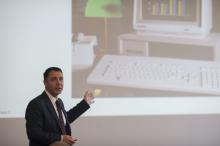 gas turbines – how actually we’ve got to engage with our customers and serve them in the use of those technologies. I went on to talk about my business, in industrial control systems. But, as an example, I’ve highlighted how in supplying trains to UK operators of course we have contracts that share the risk associated with their availability, and there is a high expectation that we make our trains available. I’ve highlighted here how we used technology to ensure that we can keep them well serviced and understand what’s happening to them, like using laser technology to see the state of the break discs whilst it’s in use, or sonar technology to look at the sound patterns to understand whether or not there are wheel bearing problems. What you can do then is predict when you might need to bring a train in to service it. It means you can stretch the use times between major service interventions.
gas turbines – how actually we’ve got to engage with our customers and serve them in the use of those technologies. I went on to talk about my business, in industrial control systems. But, as an example, I’ve highlighted how in supplying trains to UK operators of course we have contracts that share the risk associated with their availability, and there is a high expectation that we make our trains available. I’ve highlighted here how we used technology to ensure that we can keep them well serviced and understand what’s happening to them, like using laser technology to see the state of the break discs whilst it’s in use, or sonar technology to look at the sound patterns to understand whether or not there are wheel bearing problems. What you can do then is predict when you might need to bring a train in to service it. It means you can stretch the use times between major service interventions.
I think there’s a big push towards digitising transportation and, in particular, looking at, for example, what you could do with a digital railway. Whilst I didn’t cover it today, Siemens are looking at how you improve the passenger experience using technology. How you digitise not only the production of the train, but how you digitise the operation of the train in every respect.
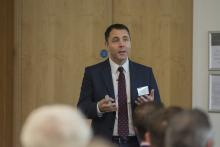 I’ve used my talk to highlight that digital, or building a digital asset base, building information about your product, from when you design it to when you make it, is going to increasingly benefit those that then have a service relationship with their customer. It may be that for some parts of our portfolio we build a product, we ship it and that’s the end of our relationship with it, or that customer. Of course, for many customers, they want to engage with us afterwards. So, if we’ve been able to build a rich knowledge base about our product, how we’ve built it, what’s happened to it since, or indeed our customers are able to use our technology to do that for their cars or planes or electronic devices, that data can be further exploited in service operations.
I’ve used my talk to highlight that digital, or building a digital asset base, building information about your product, from when you design it to when you make it, is going to increasingly benefit those that then have a service relationship with their customer. It may be that for some parts of our portfolio we build a product, we ship it and that’s the end of our relationship with it, or that customer. Of course, for many customers, they want to engage with us afterwards. So, if we’ve been able to build a rich knowledge base about our product, how we’ve built it, what’s happened to it since, or indeed our customers are able to use our technology to do that for their cars or planes or electronic devices, that data can be further exploited in service operations.
Digitalisation helps us to better understand our products, how we built them, how we interact with them, how they are used. When used for feedback, feedback from the field, or feedback into design, hopefully we repeatedly build better products. It’s not that we weren’t able to do that before, but if you imagine the shift, from paper-based methods when we used drawing boards to design products in the past, or increasingly sophisticated models to build electronics and so on. Today, of course, we are talking about high definition three dimensional models and we are using people – virtual people – to interact with the product and work out what’s possible. Can they commit to a service operation, can they do that without harming themselves – for example, reaching into an engine bay of a car or into an aircraft, and commit a service operation. Digitising not just the product, but the operation of interacting with it means that we are sharing knowledge much more than we were before. We are able to build on knowledge and we are able to repeatedly do things better if we are to continue to collect data and use it in that way.
 When you look at the digital enterprise, and I guess this is the value chain that I centred in on for our organisation, thinking about how you make things in particular – or design and make, rather than thinking about the supply chain. It strikes me that there are four pillars, that will help set an organisation up to become a digital enterprise. The first of which is creating a data backbone, creating a single version of the truth for data related to the design of the product and design of the plant, and when kept up to date that means you can go back to it quickly when you need to commit to changes or update what you are doing. The second pillar is having a communications network that enables you to ensure that you are collecting all of the data. In an industrial environment it may well be not just measured values but also parameters like the number of strokes on a value, that might be an indicator to a likely failure at some point in the future. Being connected is key, so a data back-bone and a communications system are one and two. Thirdly, we are interested in data security – keeping data safe – whether it is the IP related to the product or the process or indeed trying to ensure that we are not building systems that could be exploited by others for commercial or other reasons. That’s key when we are talking about IP connections. And finally, data analytics. The first three enable us to extract data safely from the design and production environment. The forth, the analytics, is about exploiting that data and creating value from it. Looking at outlying trends in manufacturing batches, for example, or looking at customer feedback alongside product feedback that might have come back from technology in the field. Even just looking at energy analytics or condition monitoring, better exploiting the data, now that we are able to use it in a cloud environment, making it even more accessible and using platforms like ‘mindsphere’ to help extract value from that, in a new way of doing things in the digital world.
When you look at the digital enterprise, and I guess this is the value chain that I centred in on for our organisation, thinking about how you make things in particular – or design and make, rather than thinking about the supply chain. It strikes me that there are four pillars, that will help set an organisation up to become a digital enterprise. The first of which is creating a data backbone, creating a single version of the truth for data related to the design of the product and design of the plant, and when kept up to date that means you can go back to it quickly when you need to commit to changes or update what you are doing. The second pillar is having a communications network that enables you to ensure that you are collecting all of the data. In an industrial environment it may well be not just measured values but also parameters like the number of strokes on a value, that might be an indicator to a likely failure at some point in the future. Being connected is key, so a data back-bone and a communications system are one and two. Thirdly, we are interested in data security – keeping data safe – whether it is the IP related to the product or the process or indeed trying to ensure that we are not building systems that could be exploited by others for commercial or other reasons. That’s key when we are talking about IP connections. And finally, data analytics. The first three enable us to extract data safely from the design and production environment. The forth, the analytics, is about exploiting that data and creating value from it. Looking at outlying trends in manufacturing batches, for example, or looking at customer feedback alongside product feedback that might have come back from technology in the field. Even just looking at energy analytics or condition monitoring, better exploiting the data, now that we are able to use it in a cloud environment, making it even more accessible and using platforms like ‘mindsphere’ to help extract value from that, in a new way of doing things in the digital world.
From an engineering perspective, if you think back to picture a drawing offing office, in which of course you’ve got serial processes which were linear, but now, with the digital twin, you are building a complex model collaboratively. You have got people working at the same time on the same data in a collaborative product management sense, but by painting a rich and complex picture of the device you are able to view it and bring it to life. You can isolate its characteristics and think about the materials or the suppliers, or you might test it in ways virtually that simply wouldn’t have been possible with earlier methods. What it means in particular is that for the product you can virtually prototype, so you can get much closer to having a near to market product designed and built from those virtual models. From what I have covered today, the digital twin concept is just as valid when you take it into the plant. If you are thinking then about the production environment itself, as manufacturers, we have to think about the best way to lay out the factory. As we bring in new product lines or we start to think about ways of making ourselves more productive and reducing waste, that might mean making a number of scenarios. Rather than picking physical machines up and moving them around and having down time, being able to digitise those by scanning the factory, or putting the data that we’ve got associated with them into the computer model we can then run those scenarios in the computer before deciding how to commit to changes in the real world. The digital twin concept is genuinely exciting, not just from design but to make and, I think increasingly, in service. What happens if you take the information you understand about your product and you give it to your service technicians. You give it people who are then able to guide people remotely, because they’ve understood the work instructions in a meaningful way. They can see a 3-D model; they can see how to disassemble a device in the field. A digital twin that’s an up to date real-time version of the real world could mean having multiple versions of a product that is in the field and being able to pull out of the computer hard drive the particular version that your engineer or your technician or customer is looking at remotely, and being able to see in a much more tangible way what it is they are going to have to do to interact with it in service use as well. For design, make and service the digital twin is genuinely exciting.
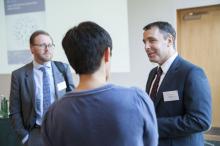 Industry 4.0 is quite a useful title to allude to a 4th industrial revolution. The 4.0 sounds like a version of software, but it does allude to a productivity shift – a significant shift. The first industrial revolution, which was really brought about by mechanization of machines being used for the first time, largely driven by water, was a big shift from the cottage industries that existed before the 1780’s. Electrification and the introduction of machines, along with division of labour, was another significant step forward in manufacturing. You can picture the Model T Ford – it was mass production that came to the fore. In the 1960’s automation – robots being used in the car plants for the first time – we have this sense of robots being able to undertake activities that people couldn’t. Factories came more productive and were able to produce higher quality, higher consistency products than handmade approaches. Industry 4.0 is really just picking up on a convergence of a number of topics; the internet of things, the power of micro-processors, communications and computing capability, along with some of those concepts we’ve talked about here today – like digital twin – and imagining a future even greater productivity can be derived from our exploitation of data, of software. We can see that a number of technologies today would enable that. But for factories to be fully autonomous we’ve got some way to go.
Industry 4.0 is quite a useful title to allude to a 4th industrial revolution. The 4.0 sounds like a version of software, but it does allude to a productivity shift – a significant shift. The first industrial revolution, which was really brought about by mechanization of machines being used for the first time, largely driven by water, was a big shift from the cottage industries that existed before the 1780’s. Electrification and the introduction of machines, along with division of labour, was another significant step forward in manufacturing. You can picture the Model T Ford – it was mass production that came to the fore. In the 1960’s automation – robots being used in the car plants for the first time – we have this sense of robots being able to undertake activities that people couldn’t. Factories came more productive and were able to produce higher quality, higher consistency products than handmade approaches. Industry 4.0 is really just picking up on a convergence of a number of topics; the internet of things, the power of micro-processors, communications and computing capability, along with some of those concepts we’ve talked about here today – like digital twin – and imagining a future even greater productivity can be derived from our exploitation of data, of software. We can see that a number of technologies today would enable that. But for factories to be fully autonomous we’ve got some way to go.
I tried to pick a number of examples that highlight the servitization of our business. We’re an industrial products company, but trying to find ways to engage with our customers and highlight the benefits of, for example, energy savings through our variable speed drives, often it’s not enough just to highlight its specification and what it’s capable of doing. For example, it may reduce the energy consumed through electric motor by up to 60 percent, and when – as is the case in the glass sector – that’s 25 percent of the cost of manufacturing, that adds up to a significant sum for a company like Pilkington. I showed the case study that is available online. What we were able to do was to finance an investment for them, such that they didn’t have to find cash and they didn’t have to make a capital outlay to buy the technology that were then going to save them money. We then got paid by the savings made in their reduced energy bill, and after three years they get to keep the asset, have a lower energy bill and we’ve been paid for our technology. There are a number of models which mean that we can take technology, and an understanding of what the customer is doing, and wrapping that up as a service that means that we can make progress. It is because we have got a reasonable understanding of what the technology can do in an industrial application like that.
 The CSA Seven Critical Success Factors (CSFs), have been helpful to us because they have been derived from industrial experience and I can see that they are up to date in their thinking. They have considered a number of the practical challenges that you would have encountered in servitising your business, and for companies like ours, which largely have a product they wish to sell, but increasingly needing to differentiate themselves through service, what the CSFs highlight is that you have to think about assessing your market and your internal readiness. That’s not a bad start point but applying that to putting in place the right culture and getting the structures, and having the resources – so that you are not just thinking about offering services, but you are giving people the remit to go and do it. These are all key if you want to avoid the bumps in the road that perhaps some of the contributors to the report found.
The CSA Seven Critical Success Factors (CSFs), have been helpful to us because they have been derived from industrial experience and I can see that they are up to date in their thinking. They have considered a number of the practical challenges that you would have encountered in servitising your business, and for companies like ours, which largely have a product they wish to sell, but increasingly needing to differentiate themselves through service, what the CSFs highlight is that you have to think about assessing your market and your internal readiness. That’s not a bad start point but applying that to putting in place the right culture and getting the structures, and having the resources – so that you are not just thinking about offering services, but you are giving people the remit to go and do it. These are all key if you want to avoid the bumps in the road that perhaps some of the contributors to the report found.
The progress made with digitalisation and technology today has been a dramatic change, and it makes me smile to thing about the progress made. I started my presentation today showing an old pc with a 5 ¼ inch floppy drive, and you’ve only got to look at the most basic of smart devices now to see the progress made, from a time when you couldn’t imagine having the information at your fingertips that we have now. I can just see that accelerating even more. I guess in my career as an engineer I’ve thoroughly enjoyed seeing progress, I’ve loved being part of that. I love my role now, where I get to try and translate meaningfully what it is that technology does to others, as I’ve seen that progress in the course of my career.
I painted a different sectoral picture in which I can see different appetites to invest in new equipment. But I think it’s really important, particularly at the moment as we talk often about a shortage of entry level talent coming into the profession, that we find better ways to describe what engineering is, or indeed manufacturing. There’s a danger that, in media, or often inadvertently, we show engineering as being lathes and milling machines or smoke stacks from a bygone era, and it’s not about that today. Factories are clean environments, which challenging work and increasingly they are digital. I think we have to do a better job of pointing out that there are intellectually challenging opportunities for young people to consider a career in engineering today. I feel a sense of responsibility to try and help shift that impression that’s negatively built up around engineering.

